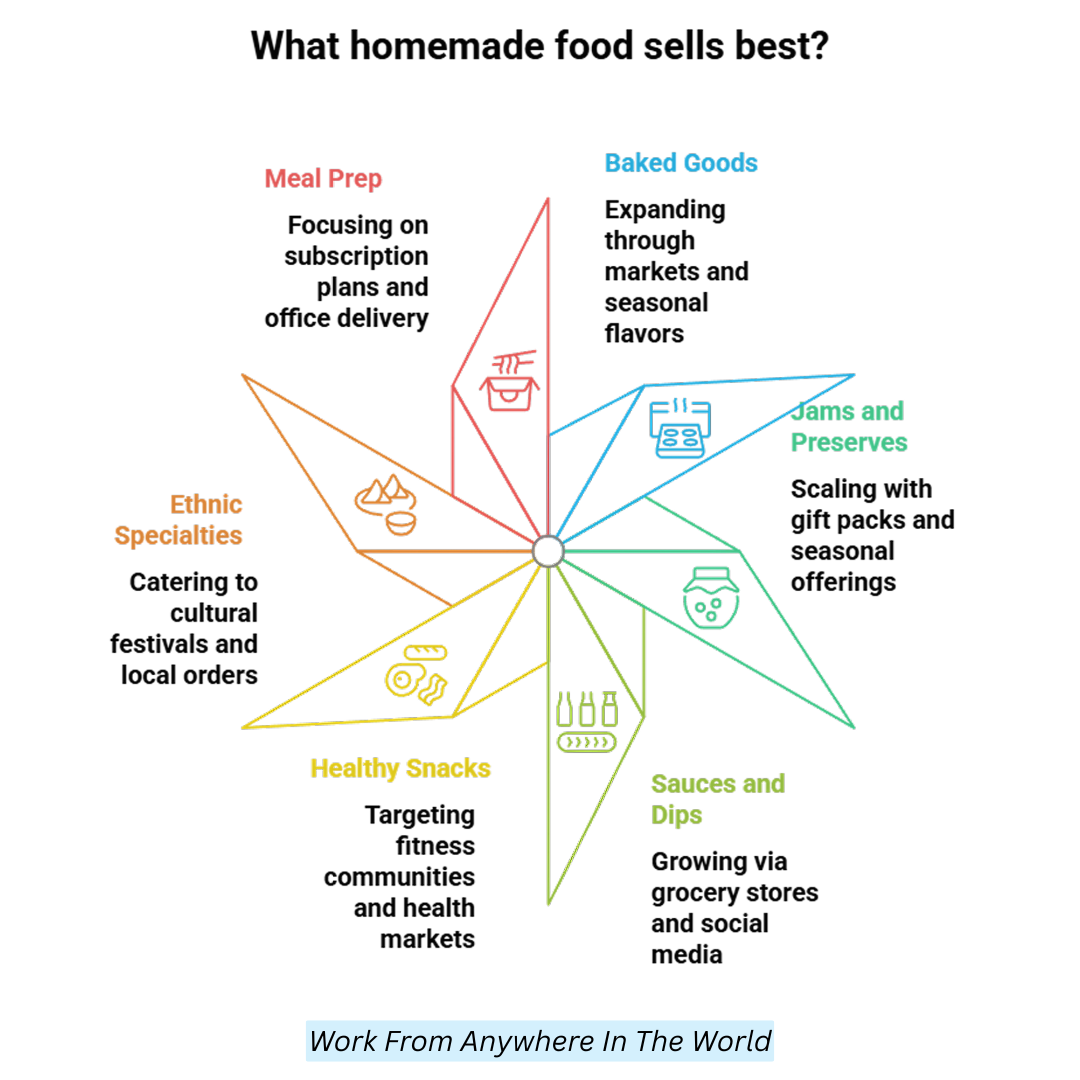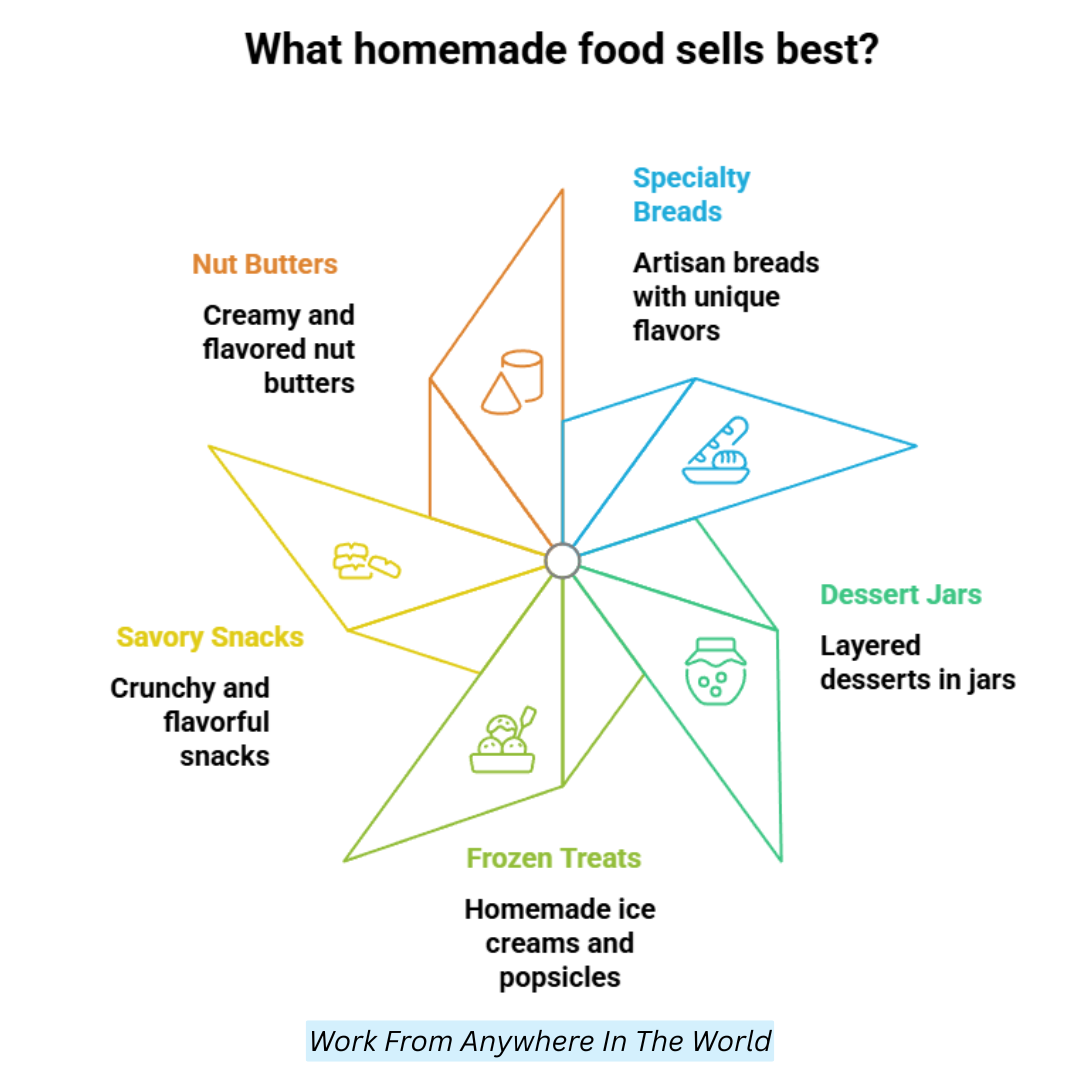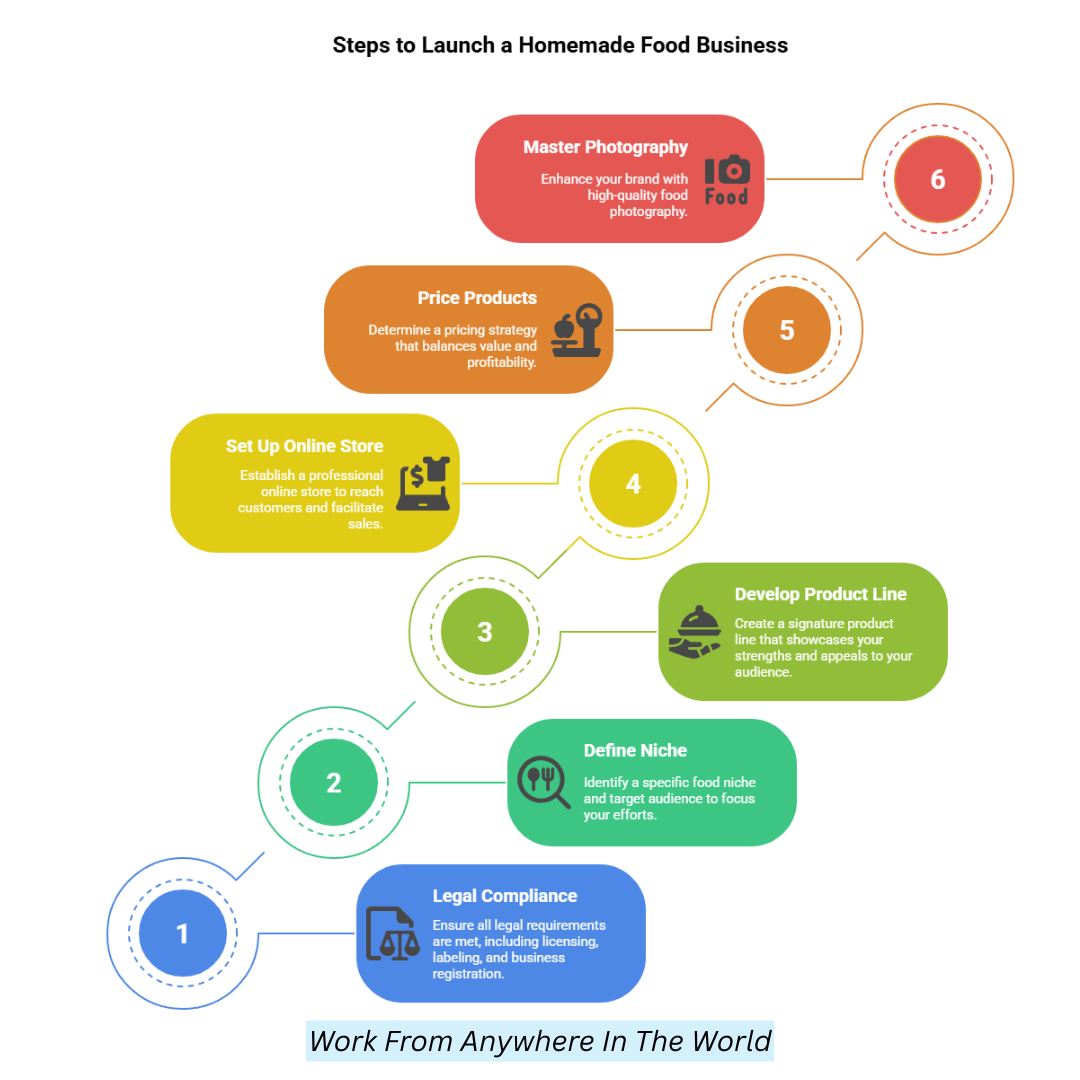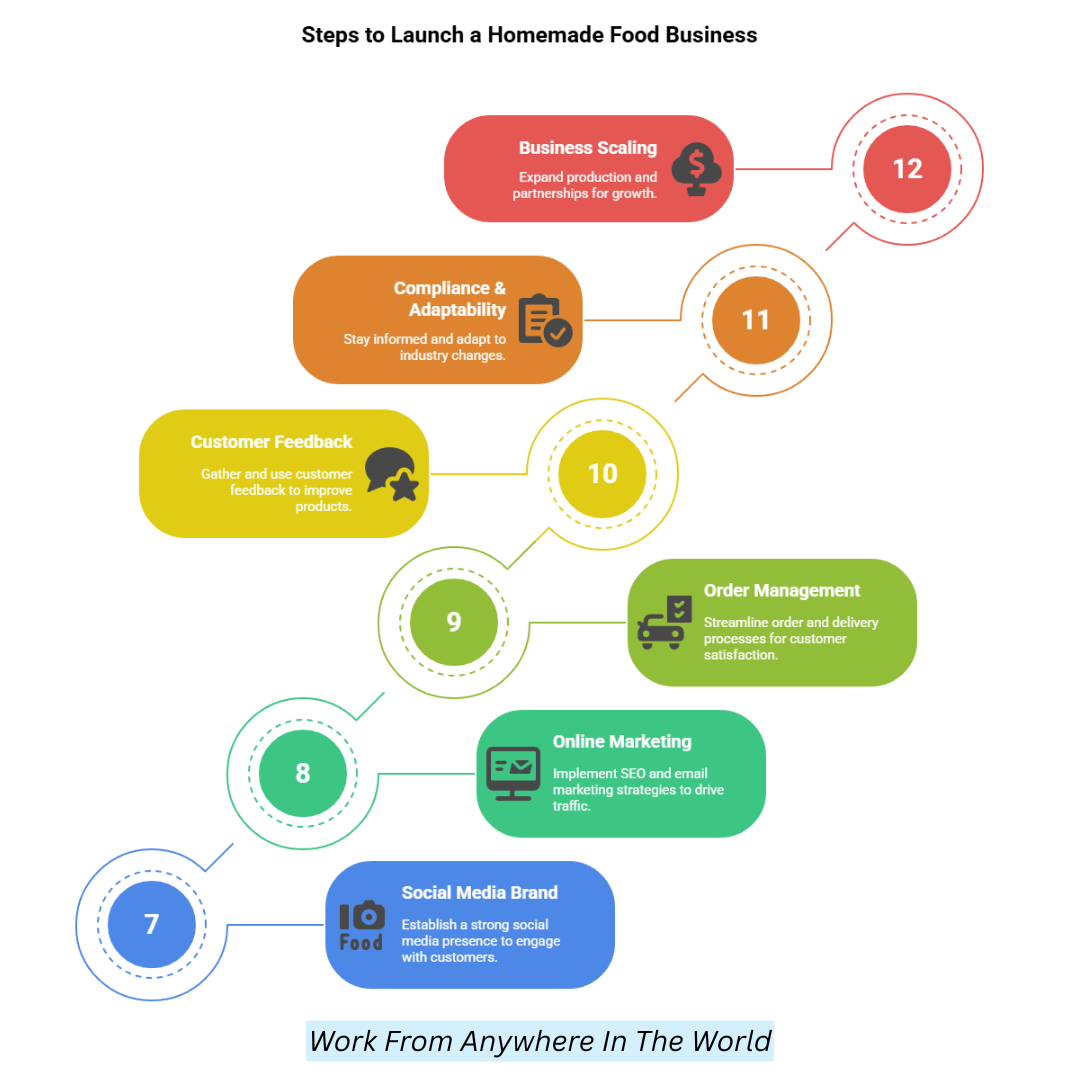How To Sell Homemade Food Online
One excellent approach to make money from your love of cooking is to sell homemade food online.
Whether baking cookies or crafting savoury meals, this guide will walk you through the essentials of how to sell homemade food online.
From legal steps to setting up your digital store, we’ll cover everything you need to know to reach hungry customers and grow your food business from home.
What Homemade Food Sells Best?
The best-selling homemade foods often depend on your local market, trends, and your skills, but here are some consistently popular options that tend to sell well:
1. Baked Goods (Cookies, Cupcakes, Bread)
Include a wide range of baked treats such as classic chocolate chip cookies, vegan cupcakes, artisan sourdough, and focaccia. Depending on ingredients and customization, prices typically range from $2 to $5 per item.
For example, SweetCrumb Bakery started selling cookies on Instagram, initially earning $1,500/month. Expanding into local farmers’ markets and introducing seasonal flavours, they grew revenue to over $5,000 monthly within a year.
2. Jams And Preserves
Craft small-batch jams with unique flavour combinations like blueberry-lavender or peach-ginger using fresh, local fruits. Jars usually sell between $6 and $10 each.
Preserve & Co. launched at farmers’ markets, earning about $800/month in the first six months. Adding gift packs and seasonal flavours, scaled to $3,000 monthly revenue, is popular among health-conscious and artisan food lovers.
3. Sauces And Dips (BBQ Sauce, Hummus, Salsa)
Offer handcrafted sauces like smoky chipotle BBQ, roasted red pepper hummus, or fresh garden salsa. Jars range from $5 to $12. SauceCraft in Brooklyn began by selling at food fairs, making $2,000/month after six months.
They expanded through local grocery stores and social media, emphasizing unique recipes and clean ingredients, appealing to busy families and foodies.
4. Healthy Snacks (Granola Bars, Energy Balls, Roasted Nuts)
Focus on wholesome ingredients like oats, nuts, seeds, dried fruits, and natural sweeteners—prices per item range from $1.50 to $3. NutriBites in Miami started as a side hustle, creating vegan-friendly energy balls sold at yoga studios.
After local cafe partnerships, they reached $1,200/month, growing steadily by targeting fitness communities and health-focused markets.
5. Ethnic Specialties (Traditional Dishes Or Desserts)
Prepare authentic dishes from cultural recipes such as Indian samosas, Middle Eastern baklava, or Polish pierogis. Items typically sell for $3 to $8 each.
Mama’s Kitchen in Chicago started with pierogis. It grew by catering to cultural festivals and local orders, increasing monthly revenue from $500 to $4,000 within a year by offering family meal kits and special event catering.
6. Meal Prep Or Ready-To-Eat Meals
Create nutritious weekly meal boxes, including vegan lasagna, quinoa salads, or hearty soups. Typically, meals cost between $10 and $15.
FreshFeast in Seattle targets busy professionals needing convenient lunches. They quickly grew from $1,000 to $3,000 monthly through subscription plans and office delivery, focusing on gluten-free and vegan menus.

7. Specialty Breads (Sourdough, Gluten-Free, Focaccia)
Offer artisan breads, including sourdough, rosemary focaccia, or gluten-free loaves. Loaves sell for $6 to $12, depending on ingredients.
Crust & Crumb began with weekly bread subscriptions, making $900/month. After adding unique flavours and seasonal varieties, they increased revenue to $3,800 monthly by partnering with local cafes and grocery stores.
8. Dessert Jars (Tiramisu, Cheesecake, Mousse)
Sell layered desserts like classic tiramisu, vegan cheesecake, or chocolate mousse in jars. Prices vary from $5 to $9 per jar. Sweet Layers launched at community markets, earning $700/month.
By creating customizable holiday gift boxes, they grew sales to $3,200 monthly and expanded into online orders and local catering.
9. Frozen Treats (Ice Cream, Popsicles, Frozen Yogurt)
Produce homemade ice creams, fruit popsicles, or dairy-free frozen yogurt. Price per serving ranges from $3 to $7. Chill & Thrill in Miami started with small-batch ice cream flavours generating $1,000/month.
After expanding to seasonal popsicles and local events, revenue grew to $4,000 monthly, appealing especially to families and tourists.
10. Savoury Snacks (Spiced Nuts, Cheese Straws, Homemade Chips)
Create crunchy, flavorful snacks like spiced nuts, cheese straws, or vegetable chips. Prices range from $3 to $7 per bag. SnackCraft began with farmers’ market sales, making $900/month.
Expanding to local specialty stores and online orders, they scaled revenue to $3,700 monthly, focusing on natural ingredients and bold flavours..
11. Nut Butters (Almond, Peanut, Cashew, Flavoured Varieties)
Make creamy or crunchy nut butters, including flavoured options such as cinnamon or chocolate-infused. Jars typically cost $7 to $15. Nutty Goodness in Seattle launched with local delivery and online orders, earning $1,200/month.
After expanding into farmers’ markets and health food stores, they increased revenue to $4,500/month, catering to fitness enthusiasts and families.

Steps To Launch A Homemade Food Business Online
1. Understand Legal Requirements
Licensing And Permits
Before selling homemade food, research your region’s licensing rules. Limited food varieties can be sold directly to customers in several places thanks to cottage food licenses.
You might also need a food handler’s permit and regular health inspections to ensure sanitary conditions. Contact your local food safety authority or health department for detailed information on the documentation.
Labelling Laws
Proper labelling isn't just courteous—it's legally required everywhere. Labels should indicate common allergens (such as dairy or nuts), identify all ingredients in descending weight order, and provide best-by or expiration dates.
If your food is prepared in a home kitchen, you may also be required to state this clearly on the packaging. Accurate labelling ensures consumer safety and builds trust with customers who value transparency.
Business Registration
To operate legally and professionally, register your food business. Choose a business structure that suits your goals—options include sole proprietorship, partnership, LLC, or corporation.
Register your business name if it’s different from your own. Even if you don't employ people, you will still require an Employer Identification Number (EIN) from the IRS for tax purposes.
This step establishes your brand and makes your business compliant with local and federal laws.
Key Points
- Research local licensing rules (e.g., Cottage Food License).
- Obtain food handlers permits and pass health inspections.
- Comply with labelling laws listing ingredients, allergens, and expiration dates.
- Register your business legally, choose a business structure, and get an EIN for taxes.
2. Define Your Niche And Target Audience
Instead of trying to please everyone, hone in on a specific niche. Consider what makes your cooking unique—do you offer vegan treats, traditional ethnic recipes, or gluten-free options for health-conscious consumers?
Once your niche is defined, identify your ideal customer. Build a customer avatar including age, lifestyle, food preferences, and digital behaviour.
Are they busy professionals seeking healthy snacks, or parents looking for allergy-friendly baked goods? Use surveys, online groups, and competitor analysis to refine your audience understanding. Knowing who you’re selling to helps you craft messaging, product offerings, and marketing strategies that truly resonate.
Key Points
- Focus on a specific food niche (e.g., vegan, gluten-free, ethnic).
- Identify your ideal customer’s demographics and preferences.
- Use surveys and competitor analysis to refine your audience.
- Tailor messaging and products to meet your customers’ needs.
Wealthy Affiliate – Mini Review (2025)
If you’ve ever thought about turning your blog, passion, or niche into an online business,
Wealthy Affiliate (WA) is one of the most beginner-friendly platforms I’ve used.
It combines step-by-step training, website hosting, SEO research tools,
and an active community all in one place.
What I like most: you can start free (no credit card needed),
explore lessons, test the tools, and connect with other entrepreneurs
before upgrading. WA isn’t a “get rich quick” scheme — it’s a platform where success comes
from consistent effort and applying what you learn.
3. Develop A Signature Product Line
Your product line should start with a few standout items that showcase your strengths. Choose recipes that are not only delicious but can also be made consistently and safely at scale.
Test these products with family, friends, and local food communities to gather feedback and refine your offerings. Think about shelf-life, storage needs, and how they will hold up in transport.
Regarding packaging, use food-safe, eco-friendly containers that protect the product during shipping. Custom labels should include your logo, product name, ingredients, allergen information, and preparation or storage instructions. Branding and quality presentation are key.
Key Points
- Start with a few standout, scalable recipes.
- Test products for taste, shelf-life, and transport durability.
- Use food-safe, eco-friendly packaging with clear branding and labelling.
- Emphasize consistent quality and attractive presentation.
4. Set Up A Professional Online Store
Your website is often the first impression your customers will get, so make it count. Build your store using eCommerce platforms like Shopify, Wix, or Squarespace.
Choose a clean, intuitive layout with high-quality product photos, detailed descriptions, prices, and ingredients. Create an FAQ page that addresses common concerns such as shipping times and allergens, and include a contact page for direct support.
Your store must be mobile-optimized, load quickly, and offer secure checkout options like PayPal or Stripe. Add tools for inventory tracking, order notifications, and automatic shipping updates to streamline your operations.
Key Points
- Build a user-friendly eCommerce website on platforms like Shopify or Wix.
- Include high-quality photos, detailed descriptions, and ingredient info.
- Make your store mobile-friendly with secure payment options.
- Implement tools for inventory, order tracking, and customer support.
5. Price Your Products Smartly
To succeed, your pricing should reflect both value and profitability. Begin by calculating the cost of ingredients, packaging, utilities, labour, and delivery.
Don’t forget to factor in marketing expenses, taxes, and platform fees. After calculating these costs, add a markup that aligns with industry standards and your target audience’s expectations.
Research competitor pricing to stay competitive without underselling. Consider bundling items or offering tiered pricing for bulk orders.
Finally, include a margin for discounts and special offers, so your business can run promotions without affecting your bottom line.
Key Points
- Calculate total costs (ingredients, labour, packaging, marketing, fees).
- Add a competitive markup based on industry standards.
- Research competitor prices and consider discounts or bundles.
- Ensure pricing balances value and profitability.
6. Master Food Photography
Great photos can elevate your brand and boost sales. Natural light is the first step in making your food appear fresh and enticing.
Use a smartphone or DSLR with a good camera, and experiment with different angles—overhead, side, and close-up shots—to showcase textures and presentation.
Keep your background simple, clean, and on-brand to avoid distractions. Props like rustic plates, napkins, or cutting boards can enhance your scene, but don’t overcrowd it.
Edit your photos to enhance brightness and clarity without distorting the food. Invest in a professional food photographer or take a short food photography course.
Key Points
- Use natural light and simple backgrounds to highlight food.
- Experiment with angles to showcase textures and appeal.
- Edit photos to enhance clarity without distortion.
- Consider professional photography or training for better results.

7. Use Social Media To Build A Brand
Social media is your best friend for building a following and increasing sales. Focus on platforms like Instagram for beautiful food photos, TikTok for entertaining cooking videos, and Facebook for engaging with local communities.
Post consistently with a content calendar and use a mix of content types—product shots, behind-the-scenes videos, customer reviews, and educational posts.
React to messages and comments to build a solid rapport with your audience. To boost participation, hold surveys or contests.
Use relevant hashtags, geotags, and cross-promotions to expand your reach. A well-managed social presence helps humanize your brand and build trust.
Key Points
- Focus on Instagram, TikTok, and Facebook for engaging content.
- Post consistently with diverse content (photos, videos, reviews).
- Interact with followers and run contests or polls for engagement.
- Use hashtags, geotags, and collaborations to widen reach.
8. Leverage Online Marketing Techniques
Having a good marketing strategy is essential to increasing store visitors. Start with SEO: research keywords related to your food and include them in your product descriptions, page titles, and blogs.
Collaborate with local food bloggers or micro-influencers to reach a wider audience with genuine evaluations. Use email marketing solutions such as Mailchimp to deliver welcome messages, product updates, and unique offers.
Consider targeting your ideal customer by investing in paid ads through Facebook, Instagram, or Google Ads. Retargeting ads can bring back visitors who didn’t buy. Monitor performance through analytics tools and adjust campaigns for better results over time.
Key Points
- Make your product pages and website more keyword-friendly.
- Use email marketing for updates and exclusive offers.
- Partner with micro-influencers and bloggers for reviews.
- Invest in targeted paid ads and retargeting campaigns.
- Track performance and adjust marketing strategies regularly.
9. Manage Orders And Delivery
Efficient order management ensures happy customers. Choose an eCommerce platform that tracks inventory and automates order confirmations.
Offer multiple delivery options, including local pickup, courier services, or shipping through carriers like FedEx or UPS. Use insulated or vacuum-sealed packaging to maintain freshness, especially for temperature-sensitive items.
Include tracking numbers and send regular order updates via email or SMS. Provide detailed return and refund policies to avoid disputes.
Consider customer satisfaction follow-ups after delivery. Platforms like Shippo or Easyship can simplify logistics and provide discounted shipping rates. Reliability builds trust and encourages repeat business.
Key Points
- Choose platforms that automate order and inventory management.
- Offer multiple delivery options, including local pickup and shipping.
- Use proper packaging to maintain freshness during transit.
- Provide tracking info, clear policies, and follow up on satisfaction.
10. Gather And Use Customer Feedback
To make your products and client experience better, you need feedback. Set up automated emails requesting reviews after a purchase.
Offer small incentives like discounts on future orders for completing surveys. Monitor review websites and social media to see what people say about your company.
Categorize feedback into product quality, delivery experience, website usability, and customer service. Use this information to make necessary improvements—tweaking a recipe, changing packaging, or clarifying product descriptions.
Emphasize gratifying evaluations on your website and social media accounts to establish credibility and persuade potential clients to believe in your products.
Key Points
- Automate review requests and offer incentives for feedback.
- For consumer information, keep an eye on review websites and social media.
- Use feedback to improve recipes, packaging, and website usability.
- To establish credibility and trust, highlight good ratings.
11. Stay Compliant And Adaptable
Food industry laws and customer preferences evolve, so staying informed is vital. Subscribe to industry newsletters, local food safety updates, and follow relevant social media groups or government pages.
Attend virtual or in-person seminars and expos to stay ahead of trends and regulatory changes. Continuously review your ingredients, suppliers, and packaging to ensure they meet new standards.
In response to consumer feedback and market demands, be ready to modify your product offerings. Keep a flexible mindset, experiment with seasonal items or dietary trends, and always maintain compliance with health and business laws to avoid setbacks.
Key Points
- Keep up-to-date with food laws and industry trends.
- Attend seminars and subscribe to relevant newsletters.
- Review suppliers and packaging for compliance.
- Adapt products based on regulations and customer preferences.
12. Scale Your Business
Once your business is stable, you can look toward expansion. Start by increasing production—hire staff or outsource specific tasks like packaging or delivery.
Offer subscription boxes or bundles to generate recurring revenue. Explore partnerships with local cafés, shops, or food markets to boost brand visibility.
Apply to join local or national food fairs to meet new customers and test new products. Consider using co-packing services to produce at scale without expanding your kitchen.
Expand your product line thoughtfully based on best-sellers. Scaling requires organization but opens the door to new revenue and brand opportunities.
Key Points
- Increase production by hiring or outsourcing tasks.
- Introduce subscription boxes or product bundles.
- Partner with local shops and attend food fairs for exposure.
- Use co-packing services for larger-scale production.
- Expand product lines based on customer demand and best-sellers.

Conclusion
Are you prepared to make your kitchen creations a profitable business? This guide on how to sell homemade food online has walked you through every essential step, from legal setup to reaching customers.
You can build a successful online food brand with the right approach, passion, and consistency. Keep learning, stay creative, and soon you'll see how rewarding it is to sell your homemade food online to a broader audience.
I trust you enjoyed this article on How To Sell Homemade Food Online. Please stay tuned for more insightful blogs on affiliate marketing, online business, and working from anywhere in the world.
Take care!
— JeannetteZ
💬 Your Opinion Is Important To Me
Do you have thoughts, ideas, or questions? I’d love to hear from you. Please leave your comments below or email me directly at Jeannette@WorkFromAnywhereInTheWorld.com.
📚 More Work From Anywhere Reads
🚀 Ready to Build a Business You Can Run from Home
Or from Anywhere in the World?
Imagine creating income on your terms — from home, a cozy café, or wherever life takes you.
With the right tools, training, and community support, it’s entirely possible.
Start your own online business for free — no credit card needed.
Disclosure
This post may contain affiliate links. As an Amazon Associate and participant in other affiliate programs, I earn from qualifying purchases at no extra cost to you. Please read my full affiliate disclosure.







